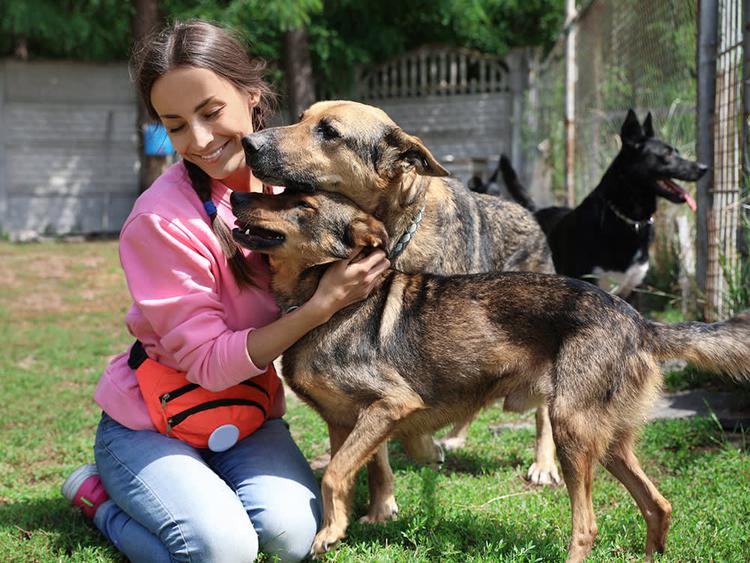Learn How To Feed A Dog: A Food Guide for New Dog Parents
Curious about how to feed your new dog? This guide will answer your questions.
Curious about how to feed your new dog? This guide will answer your questions.
by Dr. Amy Fox, DVM, | July 12, 2023

Mal de Ojo Studio / Stocksy
Whether you have always had dogs or are about to adopt your very first pup, figuring out what to feed them can feel overwhelming — especially with all the options out there. But don’t worry: We broke down everything you need to know about feeding your new dog.
Dogs are considered omnivores like humans, which means they can eat a wide variety of food to meet their nutritional needs. They get a balanced diet from a combination of proteins, fats, minerals, vitamins, and other nutrients, including fiber, carbohydrates, and water. Some foods are toxic to dogs, even though they are safe for humans, including chocolate, grapes, onions, garlic, and sugar-free products containing Xylitol, so it is important to keep them out of your dog’s reach.
The main types of dog food are wet food and dry kibble, but there are also some alternatives, including home-cooked food, raw food, and freeze-dried raw food. It’s important to select food labeled as complete and balanced for your dog’s life stage and meets AAFCO nutrient profiles. Some products are only intended as supplements to a primary diet or as treats, and they don’t include all of the nutrients a dog needs long-term.
Figuring out how much to feed a new dog can be tricky, especially if they came from a shelter or were rescued as a stray. They may be very thin when you adopt them, so the amount they need to eat at first may be different than what they will need for long-term weight maintenance. Also, new dogs are adjusting to new experiences, new people, and new smells and sounds, and their appetite may be low for the first few weeks while they settle in.
A good rule of thumb is to use the guidelines on the food label itself. The label will advise how much to feed based on your dog’s weight and age. These recommendations tend to be generous, so don’t feed more than the label recommends unless directed by your veterinarian. In some cases, your dog may eat much less than suggested, especially at first. If you are concerned that your pup may be eating too much or not enough, contact your veterinarian for help tailoring a feeding plan to your dog’s caloric needs.
It is also useful to be in the habit of measuring out your dog’s food in a consistent way, such as with a spare measuring cup or spoon, so you use the same amount each time. If you need to adjust your pup’s diet due to concerns about their weight, having a consistent starting point will help you easily increase or decrease their feedings by a set quantity.
If your dog is coming from a foster home or animal shelter, it is a good idea to continue feeding them the food they are used to while they adjust to their new home. Sudden food changes may cause diarrhea, so if you want to change their diet, gradually mix small amounts of new food with their current diet in increasing amounts over about seven days.
You should also consider your lifestyle and circumstances. For example, canned food only lasts a few days in the fridge once opened and should not be left out for more than an hour or so. It can also be expensive to feed only canned food to very large dogs as they will need large portions. Dry food is convenient because it is stable for longer periods of time at room temperature and can also be great for training sessions and food puzzles. Raw food diets are controversial because they can put pets and people at risk for food-borne illnesses like Salmonella and E. coli.
Ultimately, there are many factors to consider when selecting the best food for your dog, including the following.
Some breeds are more prone to certain health conditions that could affect the nutrition they need. For example, large-breed dogs are more likely to have certain bone and joint problems and may need food that is low in calories and high in joint-supporting nutrients, especially during the growing puppy stage. There are specially formulated large-breed puppy foods available for this reason.
Puppies and senior dogs have different nutritional needs than adult dogs. Puppies need food high in calories and nutrients to support their growth and development. Senior dogs may need food that is lower in calories and easier to digest. Make sure whatever food you are considering is specifically labeled for use in their stage of life.
This is a unique time in a dog’s life when she needs a lot of extra calories and an increased amount of specific nutrients like calcium. It is very important to make sure all pregnant and nursing dogs are eating a diet labeled for this life stage, or they can be at risk for serious health problems such as Eclampsia.
Active dogs need food that is higher in calories and nutrients to support their energy needs. Less active dogs may need lower-calorie food to avoid weight gain. This may also influence how often you feed your pup, as active dogs may need more frequent feedings, especially after intense exercise.
Some dogs have health conditions that require them to eat a special diet. There are diets formulated for specific health conditions, many of which are only available from a veterinarian or with a prescription. For example, dogs with a history of bladder stones may need to eat a special diet to prevent a recurrence of stones, and dogs with diabetes need food that is lower in calories. It is a good idea to speak with your veterinarian if you know your dog has health problems so you can get a good diet recommendation.
Most adult dogs can be fed twice daily, approximately 10 hours apart. Make sure to figure out the total daily portion for your pup and split that up so you always maintain the same total amount of food for the day. Also try to develop a consistent routine and feed them at the same time and in the same place every day.
Puppies need more frequent feedings because their stomachs are so small; they can only eat enough food to provide a few hours of energy at a time. They should have small, frequent feedings throughout the day.
Dogs with certain health conditions may also need more frequent, small feedings throughout the day, such as those with bilious vomiting syndrome who tend to vomit if their stomachs are empty for long periods of time.
Food can be a motivating reward for many dogs, so it can be a great tool for training. Instead of giving your puppy or adult dog in need of training a big bowl of kibble for breakfast, you can portion out that same amount of kibble and use it for treats during training sessions. Dogs who suffer from separation anxiety can also benefit from eating differently; instead of feeding them in one sitting, you can split their daily portion into different food puzzles, which slow them down, provide them with mental enrichment, and keep them busy while you are out. The important thing to keep in mind is that you maintain the same total amount of food in a given day, so if you use food as rewards or in puzzles, give your dog less food in their bowl at mealtimes so that you don’t accidentally overfeed them.
Figuring out the right balance of quantity and frequency of feedings takes time, so be patient if your dog isn’t eating perfectly. Make sure that you serve food in a clean bowl and that the food is fresh and free of mold or any other contaminants. Be sure to clean up any uneaten food within the recommended time frame, which differs for wet and dry foods. Uneaten food should be discarded, and fresh food should be provided at the next feeding.
If you adopted a pup who was already underweight, overweight, and/or has underlying medical conditions, expect it to take some time to get into a steady groove. Some problems you’ll want to be aware of include:
Some dogs are prone to overeating. This can happen because they are being fed too much, or their diet is too high in calories compared to their body’s needs. This can also be a compulsive issue for some dogs, especially dogs who have gone hungry for long periods of time in the past, or for dogs with certain medical problems. Overeating can lead to obesity, which can increase the risk of health problems such as heart disease, diabetes, and arthritis. If you are concerned that your dog is putting on weight or always seems hungry, see your veterinarian for an evaluation.
Some dogs may not eat enough to maintain their body weight due to a number of factors, including illness, stress, or a picky appetite. In other cases, they may be eating enough, but the food may not have enough calories to meet their needs, which most commonly occurs if they are growing, pregnant, or extremely active. If your dog seems thin or you have concerns that you are underfeeding your puppy, contact your veterinarian.
Some dogs are very picky eaters, which can lead to nutritional deficiencies. Try to avoid offering lots of extra yummy alternatives when your dog snubs their food because, if they learn something better comes when they don’t eat, they’ll develop a pattern of skipping their dog food. Any dog who is frequently skipping meals or not eating should be examined by a veterinarian to determine if there are any underlying medical issues.
The best approach if you suspect your dog has food allergies is to have a veterinarian properly diagnose them and put them on the right diet to avoid those allergens. Beware of over-the-counter dog foods that claim to be limited ingredient diets because many are prepared on the same equipment as other food that may contain allergens. If your dog has a true allergy, they will need a prescription diet prepared on separate equipment to avoid cross-contamination.
If your dog is coming from a foster home or animal shelter, it is a good idea to continue feeding the same food they are accustomed to while they adjust to their new home. Be sure to ask the shelter or foster parent for the name of the food and their current routine, including how many meals they eat, how much food per meal, and what time they are fed. Too many changes at once can be overwhelming, and it is important that your new pup eats consistently.
If you decide you want to switch up your new dog’s diet once they have settled in, be sure to do so gradually by mixing small amounts of the new food with their current diet in increasing amounts over about seven days. Sudden food changes may cause diarrhea, so a gradual introduction will help to avoid this.
When deciding what to feed your new dog, remember that what works for one dog may not work for yours, and the same goes for pet parents. New pups need time to adjust to their new homes, so try to be patient and avoid making unnecessary changes in their first few months with you. If you have concerns about your dog’s appetite or overall health, contact your veterinarian and have your dog examined. Food is a love language for most dogs, so once you work out the kinks, feeding time will undoubtedly become one of your dog’s favorite activities.
Most adult dogs need two feedings per day, about 10 hours apart. Puppies and dogs with certain health conditions need small, frequent feedings throughout the day.
To start, use the guidelines on the food label. If you are concerned your pup is eating too much or not enough, contact your veterinarian for help.
There’s no reliable way to prevent food allergies in dogs. The best approach is to have your dog’s allergies diagnosed by a veterinarian and follow their recommendations.
Yes — some of the most common include chocolate, grapes, onions, garlic, sugar-free products containing Xylitol, raw dough, and moldy foods.
Dogs with a healthy diet should be a healthy weight, have shiny, full coats, and plenty of energy. They should also have regular, solid poops.
Continue feeding a foster dog the same food the shelter or foster parent has been feeding them and the same number and amount of meals at consistent times.
VCA General Nutrition and Pet Feeding Guides
AAHA Introduction to Feeding Normal Dogs
belltownevetcenter.com / Checklist for a Healthy Dog
Evaluation of nutritional value and microbiological safety in dog food
Evaluating Pet Foods: How Confident Are You When You Recommend a Pet Food?

Amy Fox, DVM is a small animal veterinarian in New York City. She has worked in many different settings including shelter medicine, emergency medicine, general practice, and animal cruelty and forensics. She is especially interested in nutrition, preventative medicine and care for senior pets. Dr. Fox also enjoys writing about veterinary medicine and teaching. In her free time she loves to cook, garden, and go for long runs.

Shelters & Rescue

Adoption Advice

Shelters & Rescue

Adoption Advice
Wondering about tax savings for pet expenses? Learn about Pet Tax Deductions to understand how to claim your pet on taxes

Adoption Advice
Not sure if you should adopt a younger or older pet? Here’s a guide to help you make the best decision.

Adoption Advice
Is the responsibility of taking care of your pet causing you to worry about your budget? Rest assured, there are a number of ways to minimize this financial stress.

Adoption Advice
Considering getting a pet but unsure if you want a cat or dog? Here are 10 differences to consider.

Adoption Advice

Foster & Volunteer
Fostering is a great way to dip your toes into the pet-parenting waters, while helping a pet in need.

Adoption Advice
Considering renting with pets? Read more to learn about renter policies and how to navigate them.
Behavior & Training

Adoption Advice
Pet parenthood can be tough, but finding the right vet doesn’t need to be. These tips will help you find the right vet for your pup.